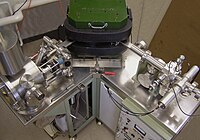
Photo from wikipedia
In this study a methodology for identifying the geographic origin of unidentified persons, their residence and moving patterns while providing information on lifestyle, diet and socio-economic status by combining stable… Click to show full abstract
In this study a methodology for identifying the geographic origin of unidentified persons, their residence and moving patterns while providing information on lifestyle, diet and socio-economic status by combining stable isotopic data, with the biological information (isotopic composition of the skeleton), is presented. This is accomplished by comparing the oxygen isotopic composition of the spring water that individuals were drinking, during their living period, with the oxygen isotopic composition of their tooth enamel bioapatite. Spring water and teeth samples were collected from individuals from three different areas of Greece: North Greece, Central Greece and South Greece and isotopic analysis of δ13C and δ18O of tooth enamel bioapatite and δ18O of spring water were conducted. For these three areas the isotopic methodology is a promising tool for discriminating the provenance. Furthermore, as a case study, this methodology is applied to two archeological sites of Greece (Medieval-Thebes and Roman-Edessa) in order to determine paleomobility patterns.
Journal Title: Scientific Reports
Year Published: 2020
Link to full text (if available)
Share on Social Media: Sign Up to like & get
recommendations!